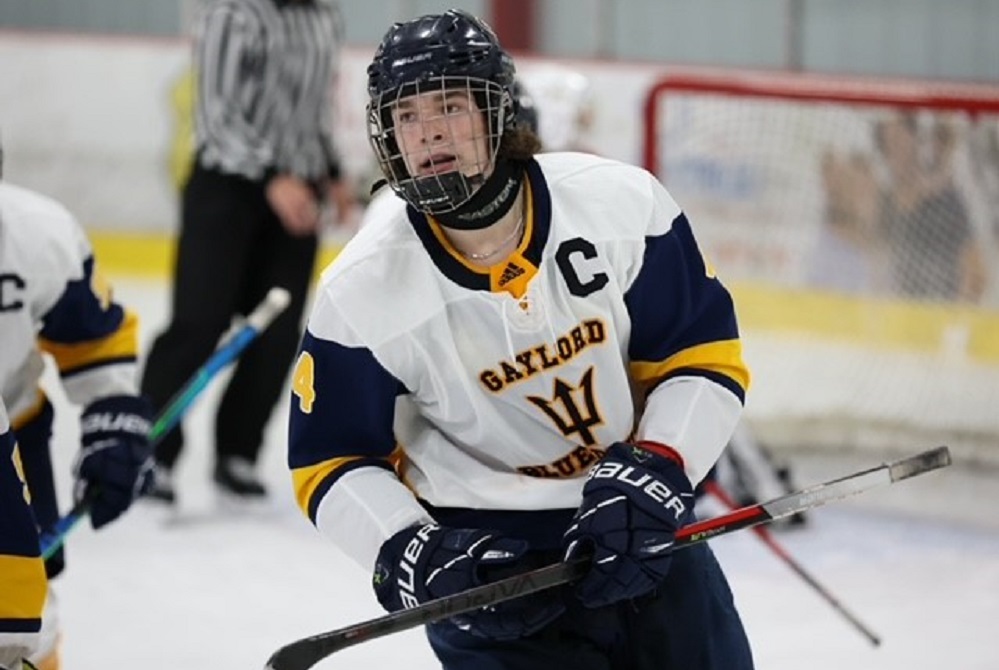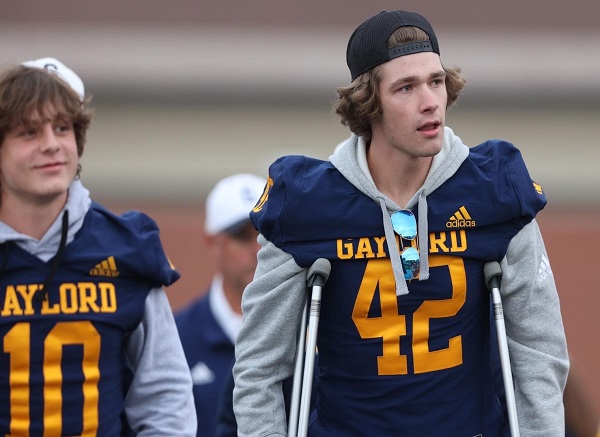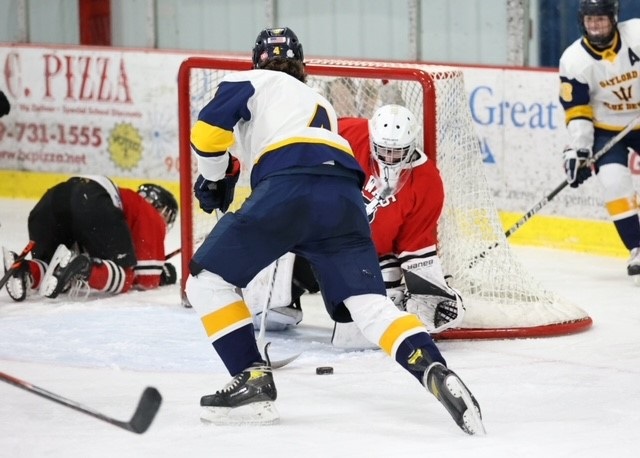
Garofalo: On-Ice Teacher and Recruiter
By
Rob Kaminski
MHSAA benchmarks editor
December 28, 2012
Something caught his eye as Allen Park’s Jim Garofalo circled the Olympic hockey rink in Salt Lake City to familiarize himself with the surroundings prior to the start of play at the 2002 Games.
“When the dimensions of a rink are laid out, everything is measured from the exact center of the ice outward,” Garofalo explains. “Usually there’s a washer or something small under the surface at center ice. All measurements are taken from there.
“Well, in Salt Lake City that year, a Canadian company was hired to prepare the sheets of ice, and they used a Loonie (common term for a Canadian $1 coin) to mark center ice. That year, the Canadians beat the United States in the gold medal game and won the Olympics on U.S. soil. I later visited the Hockey Hall of Fame in Toronto, and that Loonie is there.”
As Garofalo was getting acquainted with Canadian currency, an invitation in his mailbox back home went unanswered. At the time, MHSAA Tournament invitations were still sent by mail, so Garofalo was unaware the Association was awaiting his RSVP to accept his first Finals assignment.
“I was in Salt Lake City and had no idea. Now, of course, everything is online and by email, but that just shows how rapidly technology has progressed in the last 10 years,” Garofalo said. “So, (fellow official) Dan DiCristofaro calls and says something like, ‘Hey, do you want your state final?’ It was pretty funny; the running joke afterward was that you’ve gotta work the Olympics to get a shot at the state finals.”
Of course, that’s not the case. And, if Garofalo had it his way, all hockey officials who worked hard, persevered, paid their dues and set that as a goal would get a shot at the MHSAA Finals.
A 25-year registered MHSAA official who at one time juggled rules books for eight different hockey leagues and has worked four World Championships in addition to the Olympics, Garofalo now works only high school hockey.
“From a selfish standpoint, I suppose, I like a season that has a definite start and end to it,” says the New Boston Middle School social studies teacher, whose resume’ at one point looked like an endless Scrabble hand that included abbreviations for USA, USA Junior, Ontario, East Coast, International, International Independent and Central Collegiate hockey leagues in addition to the MHSAA.
“Being a teacher, there’s so much about the high school game that fits into education,” said Garofalo, now in his 10th year with the New Boston Huron District. “There’s so much to learn, and to help people learn at this level, from a playing and officiating standpoint.
“The people who officiate high school hockey are dedicated to improving, and as a veteran there’s an opportunity to help them learn and advance,” he says. “And, the coaches deserve kudos too. They are usually more professional and ask questions more properly than at other amateur levels. The reason is a direct result of them being accountable. They’ve got to answer to their principal or athletic director. Who are the junior and community league coaches accountable to? No one.”
 And, there’s another allure to the school game compared to which other levels pale.
And, there’s another allure to the school game compared to which other levels pale.
“The atmosphere of high school hockey is better than any other amateur level,” Garofalo says. “You go do a game at Trenton, and there’s a band. How many hockey games do you go to where there’s a band? Detroit Catholic Central and Birmingham Brother Rice have their cheering sections. It’s just a great atmosphere.”
It’s a scene that would surely help maintain the roster of younger, driven hockey officials. The trick is getting them there, according to Garofalo, one of the MHSAA’s biggest proponents for advancement and recruitment of officials.
Part of the issue is the oversaturation of games that fill Mite, Midget and other amateur schedules. Those who simply want a paycheck are never at a loss for work as long as they know how to skate.
“Hockey is unique because high school hockey is in progress at the same time as USA Hockey. An official can get twice the pay at a Bantam/Midget doubleheader than they can for one high school game,” Garofalo said. “The trouble is, who is instructing them? Who’s helping them to develop?”
To that end, Garofalo, DiCristofaro and the rest of the Northeast Hockey Referees Association established a $500 college scholarship. The recipient must be a high school hockey player who is officiating games in USA Hockey. Once they graduate from high school, many join the Association to work high school hockey.
Garofalo also offers other recruiting initiatives. In the Michigan Interscholastic Hockey League most schools play JV/Varsity doubleheaders, where the officials often let a linesman work a game at referee, while the experienced referee observes.
“At events like the Trenton Showcase, if we divide the fees differently we could get more officials involved,” he suggests. “We can do four-person crews to get our good young people some varsity experience as linesmen, and move some of our experienced linesmen to referee on the same crew with some of the top referees.”
It’s the kind of continual teaching that perpetuates the quality of officiating, and it takes time. The goal is to have the officials ready to perform when they hit the ice.
“If I put you out there to referee or pull lines, I set you up to succeed,” Garofalo says. “If I put people in too soon, I’ve set them up to fail, which leads to them leaving the game, and I haven’t done my job.”
The expectations and production of teacher and student must mesh for the system to work as intended. It requires patience as officials strive to climb the ladder, a bit of a lost art in today’s society.
“The culture of newer officials today is different. It’s a culture of immediate gratification,” says Garofalo. “Very few want to hang around eight to 10 years as a linesman before they referee, or move up. There are some very good officials who leave each year, because they haven’t become a referee, or haven’t got a tournament assignment.”
At the MHSAA Finals, Garofalo and DiCristofaro assist Jim Gagleard and the Livonia Ice Hockey Officials in heading up the off-ice officials. The inclusion and experience of such officials serves as a motivational tool which leads to improvement and retention. He also believes a four-person system in the MHSAA tournament would not only afford more qualified officials an opportunity for postseason assignments, but also provide better ice coverage as the sport’s speed has increased dramatically.
Not everyone can reach the summit, no matter the level. Even Garofalo himself, who once entertained dreams of skating in the NHL.
“The NHL looked at me a bit, but when I was at that age, it seemed all of the other linesmen were in their prime,” he said. “It is what it is.”
But, for a guy who began officiating at age 15 just to help pay for his hockey equipment, things have turned out quite well. In addition to the 2002 Olympics, Garofalo worked the Women’s World Championships in 1990, and the Men’s Worlds in Switzerland (1998), Norway (1999) and Germany (2001), working the Gold Medal game in 1998 and 1999. He’s been a fixture at the MHSAA tournament during the last dozen years.
“My wife, Mary Beth, says, ‘Wherever you go, you know someone.’ I owe that to officiating; the places I’ve gone and the people I’ve met,” Garofalo said. “It’s taken me all over the country instructing, and even overseas for some assignments. I can’t help but know people. It’s a people business.”
It might seem odd for Garofalo to even utter those words, describing the people-person this once shy kid has become. That’s one of the many rewards officiating delivers which is more valuable than any top-level assignment or game fee.
“I was quiet when I was younger. Well, when a coach is going crazy and yelling, you’ve got to speak for yourself. You learn conflict resolution,” Garofalo says, continuing as if he wrote the book on it. “‘Coach, get off the bench, quit screaming, and I’ll explain what I saw and why I called it the way I did. Then , if you have a question, I’ll answer it.’ You learn to communicate with people who don’t always agree with you.”
Then, there are the memories. Memories won’t buy a thing, but they go a long way in making 25 years on the ice, thousands of miles on the road, and countless hours away from home worth a million bucks.
“I worked 25 years for the IHL and AHL, and two years ago at the end of the regular season I was doing a Grand Rapids Griffins game. During the game, I told Brad May, ‘I’m done,’” Garofalo recalls, confiding in the gritty enforcer and one-time Stanley Cup champion who had more than 1,000 NHL games under his pads.
“At the end of the game, every guy and coach skated to me and shook my hand. Then Brad May says, ‘I heard you once worked the Olympics. It was an honor to be on the ice with you,’” Garofalo reveals, shaking his head. “Brad May said that to me.”
PHOTO: Jim Garofalo (center) officiate an NHL game. The Allen Park resident also has worked the Olympics.
NOTE: This is the sixth installment in the series "Making – and Answering – the Call" detailing the careers and service of MHSAA officials. Click the links below to view the others.

Gaylord's Looker Shows 'Different Type of Tough' in Return from Knee Tear
By
Tom Spencer
Special for MHSAA.com
February 3, 2023
When Gage Looker went down with an ACL injury in Gaylord’s first football game this fall, Liz Harding – president of the Blue Devils’ hockey boosters – was absolutely devastated.
 Looker, an all-conference hockey defenseman last winter, was playing, as a senior, in his first-ever varsity football game. Harding, also Looker’s mom, was there.
Looker, an all-conference hockey defenseman last winter, was playing, as a senior, in his first-ever varsity football game. Harding, also Looker’s mom, was there.
“I caught the one and only picture of him playing football just before he injured himself,” Harding recalled. “I was devastated!”
Doctors indicated surgery was necessary and recovery would prevent Looker from getting back on the ice, the football field and the track where Looker had dreams of great success this year.
“Knowing hockey is his passion — and thoughts of him not playing did not set well with me — Gage started what I would call standard physical therapy a couple days after surgery and then added an additional blood flow therapy with our local trainer to his weekly routine,” Harding said. “Through his hard work and determination, he is back on the ice.”
The Blue Devils, after graduating their other four all-conference players from last winter, were 2-11 this year when Looker returned to the ice against Big North Conference rival Petoskey. Gaylord has won three of seven since.
Gaylord coach Jamie Voss believes Looker’s return was pretty much a miracle. And he thinks Looker is playing at about 80 percent despite being only a few months removed from the injury.
“Gage tore his ACL and was told by doctors his sports life was over,” Voss said. “Gage would not accept this, and he trained harder than any kid I have ever witnessed to prove the doctors wrong.”
Sans injury, Voss notes Looker was certain to graduate on several all-time Gaylord hockey record lists.
“The reports on his progress and rehab were literally off the charts for this type of injury,” Voss said. “His doctors reported early that they have never seen this occur before regarding the strength developments in the afflicted areas that support his ACL tear.”
Voss admitted he had to hold his breath a little – as many Gaylord supporters did – when Looker joined the starting lineup against Petoskey. That moment came after just a week on the ice, including full contact practices.
 “More important than records to Gage was his commitment and obligation to be our team leader as our compete level was predictably down this season,” Voss said. “Gage is one of the best athletes and citizens that I have ever been allowed to coach.
“More important than records to Gage was his commitment and obligation to be our team leader as our compete level was predictably down this season,” Voss said. “Gage is one of the best athletes and citizens that I have ever been allowed to coach.
“He is not only a leader to the players on and off the ice, but Gage also is the kind of kid that coaches learn from,” Voss went on. “He is mature beyond his years.”
Looker, who started playing hockey at 4 years old, dabbled with football as a freshman although an eighth-grade hip injury kept him away from the field until this fall. Looker’s size – 6-foot-3, 245 pounds – led to many encouragements to give football another try.
“I went the rest of my high school career being told that I needed to play football,” Looker said. “So I said ‘why not’ my senior year because I could use the extra strength for hockey.”
Looker knew the morning after his one-and-only career football game that he needed medical attention promptly. A quick MRI showed extensive damage.
Looker was told he literally “blew apart” his ACL.
“My stomach dropped,” Looker said. “I was not ready for that at all.
“I was shown what my PCL looked like and then went to where my ACL should be, and it was gone — some say it was deleted,” Looker continued. “I was told I will not be able to play sports for about seven to nine months, and I was speechless.”
Two months after surgery and extensive physical therapy, Looker tried to skate. It went so well he began to entertain thoughts of playing hockey again. He may aspire to compete in track & field this spring.
“He runs a 56-second quarter mile and throws the shot put 48 feet, 10 inches,” Voss said of his dominating defender. “And although he is restricted from running, something tells me this kid will run track this spring.”
While it is not the senior hockey season it could have been without the injury, many are glad to just have Looker on the ice. His mom is among them.
 “I am overjoyed to have him back on the ice,” Harding said. “At least he is getting in a few games and is out there making a difference.
“I am overjoyed to have him back on the ice,” Harding said. “At least he is getting in a few games and is out there making a difference.
“The smile on his face is priceless,” she continued. “Perhaps he'll continue with track as he is set to break records there too.”
Rehab fresh out of surgery was “very boring,” so Looker started intensifying his recovery with therapy four days a week for a few months.
“It was a lot of commitment, but I needed my senior year of hockey,” Looker said. “I was doing the basic things, and then I had a machine that could stimulate my muscles and pump blood to my knee.
“It is called ARPneuro,” he continued. “I was skating with that on my leg as well as doing mini workouts at home.”
ARP — accelerated, recovery and performance — reportedly accelerates recovery time by decreasing chronic pain and increasing range of motion without the use of medications.
“I was always putting as much work in as I could,” Looker said. “It definitely paid off in the end.”
Looker’s coach agrees.
“I have never heard of this, nor witnessed it,” Voss said. “Gage Looker is an anomaly, and in my opinion a different type of tough.
“Gage returned to practice full contact three months after he tore his ACL,” Voss continued. “And he played his first hockey game logging 30 of 51 minutes a week later.”
Looker credits the support and effort of his medical team and his teammates for helping him get back on track. However, no one gets more credit that the booster president.
“My mom and teammates helped me through it,” he said. “My mom was always on me about doing my workouts and keeping me disciplined.”
 Tom Spencer is a longtime MHSAA-registered basketball and soccer official, and former softball and baseball official, and he also has coached in the northern Lower Peninsula area. He previously has written for the Saginaw News, Bay County Sports Page and Midland Daily News. He can be reached at [email protected] with story ideas for Manistee, Wexford, Missaukee, Roscommon, Ogemaw, Iosco, Alcona, Oscoda, Crawford, Kalkaska, Grand Traverse, Benzie, Leelanau, Antrim, Otsego, Montmorency, Alpena, Presque Isle, Cheboygan, Charlevoix and Emmet counties.
Tom Spencer is a longtime MHSAA-registered basketball and soccer official, and former softball and baseball official, and he also has coached in the northern Lower Peninsula area. He previously has written for the Saginaw News, Bay County Sports Page and Midland Daily News. He can be reached at [email protected] with story ideas for Manistee, Wexford, Missaukee, Roscommon, Ogemaw, Iosco, Alcona, Oscoda, Crawford, Kalkaska, Grand Traverse, Benzie, Leelanau, Antrim, Otsego, Montmorency, Alpena, Presque Isle, Cheboygan, Charlevoix and Emmet counties.
PHOTOS (Top) Gaylord’s Gage Looker has returned to the ice this season only a few months after a serious knee injury. (Middle) Looker, right, watches his football teammates from the sideline this fall. (Below) Looker tries to stuff the puck past Tawas’ goaltender. (Photos by Rob DeForge/RD Sports Photo.)

